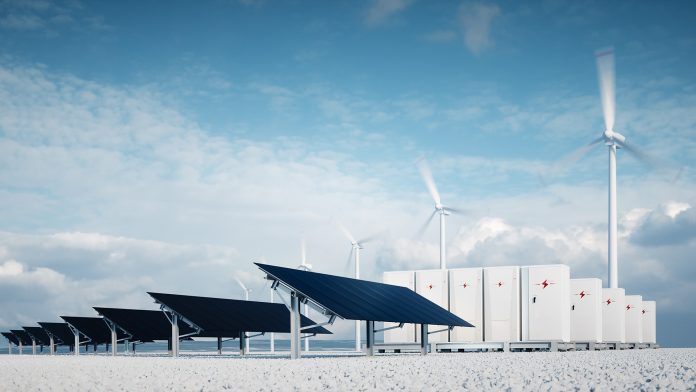Anna Darmani, Lead Analyst, Energy Storage, at Wood Mackenzie, details the findings from the company’s report on European grid-scale energy storage and outlines projections for the future of the energy storage market.
The European energy storage market has experienced a major shift in recent years as various societal events have plunged it into the spotlight. In the wake of the COVID-19 pandemic and the ongoing war in Ukraine, the clean energy transition has accelerated at an unprecedented rate as the urgency to transform Europe’s energy system has greatly intensified. However, with innovation in renewable technologies rapidly increasing to meet new targets, it has become more difficult to ensure a balanced grid to provide a stable energy supply.
With this being said, energy storage solutions are now more in the spotlight than ever and the energy storage market is experiencing a period of rapid change. Mapping out the recent changes in the European energy storage market, research and consultancy group Wood Mackenzie have compiled a report, ‘Europe grid-scale energy storage outlook 2022’, offering a ten-year forecast for the energy storage markets in 18 European countries. The report also explores drivers and barriers and highlights strategic takeaways for industrial players and governments. To find out more about the report’s findings and recommendations, The Innovation Platform spoke to Anna Darmani, Lead Analyst, Energy Storage, at Wood Mackenzie.
Can you start by providing a brief overview of your report, ‘Europe grid-scale energy storage outlook 2022′? Why was the report commissioned? How was it compiled?
I work as part of the energy storage research team for Wood Mackenzie. We regularly receive client enquiries for market overviews and updates, including what the key drivers and barriers are and the things to be aware of moving forward. For example, the European energy storage market was very slow for a while but is now gaining pace. There are lots of questions about what is changing in the market, what has happened, and why it receives so much attention. Clients want to know where they should invest and what areas they need to give more focus to, which is why we publish European outlooks every year.

For the energy storage market, we have two reports: the grid-scale energy storage report and a distributed outlook, which focuses on residential and community, commercial and industrial (CCI) energy storage.
With the grid-scale report, we look at 18 European countries, and divide them into three tier groups, based on the potential installation of capacity of energy storage in the next ten years. From here, we determine the important drivers and try to highlight these to show our clients the parameters they must look for if they want to successfully invest in energy storage of a country. We also analyse market development trends and explain the dynamics behind them.
The information in the report is aimed to support our clients in making the best strategic and operational decisions for their companies. We try to make it as comprehensive as possible and aim to answer all client questions. On the rare occasion that we do not have the answer or the data available to support a client, we will transfer them to our consulting team to assist.
To compile the report, we used data from our partners and public sources. As compiling data is quite time-consuming, we collate the primary and secondary data and store it in a database that can be accessed by our clients. This includes a project database, policy database, and target database to show them what is going on in the market. Based on this data, we can make forecasts for the next ten years.
How have recent societal events altered Europe’s energy storage outlook?
We are always forecasting growth. Before COVID-19, everyone expected the European market to grow substantially, but not this much. A lot has changed since then. At that time, if you looked at why market growth in Europe was slower than other areas, such as the US, it was because the European markets were very reliable and we had a huge amount of capacity in the market because of cheap Russian gas flowing in. Therefore, the price volatility was not high enough to encourage industrial players and European citizens to invest in energy storage assets in Europe. Whilst there were always incentives to use energy storage, the financial benefit was not high enough to attract investment in battery systems.
Following the Russian invasion of Ukraine, energy prices in Europe increased far beyond expectation as the gas supply shortage questioned the power system reliability and security. Now, we have high price volatility and energy is not as cheap as it used to be.
Most countries have started to increase their renewable targets and aim to double them by 2030. But if countries set these targets, this raises the issue of reliability. For example, if we get most of our energy from solar power during the day, what do we do in the evening? You need energy storage to store this power to be able to use it when needed. So, the market fundamental has changed a lot.
On a societal scale, now there is the question of resilience, everybody wants to be more environmentally aware and electricity prices have gone up. Therefore, everybody is thinking about how they can bring their electricity prices down. These things encourage people to think differently about how they use energy or electricity and the options they have to reduce their own consumptions.
Do you think the current infrastructure is sufficient to support energy storage needs at the rapid rate of demand?
Energy infrastructure in Europe, and generally, has room for improvement. For example, there will be a lot more solar and wind power on the market but we do not have the needed distributed grid infrastructure for it. We used to have a very centralised power production, with huge power plants in one part of the country and a grid line to distribute it. Solar and wind do not work this way. Therefore, we need more investment in infrastructure, such as the grid, to be able to use these valuable renewable energies that are produced by these technologies throughout a country.
In addition, a major challenge is that regulations are very limited. First, we need better infrastructure but we also have to acknowledge the important role that energy storage can play in bringing the needed flexibility to the power markets. Most markets and corresponding regulations do not recognise this yet, which is problematic.
What do you think governments and policymakers need to consider moving forward to sustain the accelerating growth of the energy storage sector and to improve this infrastructure?
There is a lot of talk about the need for storage systems. But, to reiterate my previous point, do we have regulations that are fair towards the storage or acknowledge the role that storage can play in the market? No.
Storage is a new asset to the market and most energy storage developers looking to enter the market must go through merchant revenue and financing. Banks want to know how these new storage assets work and their profitability potential before investing, but, as they are based on merchant revenue, this is impossible to prove. Banks are therefore unwilling to fund the investments. Currently, financing is the major issue for energy storage assets, which is partly due to a lack of experience with these assets and also a lack of market fundamentals. Governments can play a huge role in this by providing systems or regulations that enable energy storage projects to prove to investors that they can be profitable. For example, renewables, for a long time now, have been supported by renewable energy auctions – whereby the government issues a call for tenders to install a certain capacity of renewable energy-based electricity – before they become more independent and the prices decrease. This is not the case for storage.
If governments acknowledge the role of energy storage, they also must implement regulations and initiatives that enable these assets to enter the market and compete. For example, we think that it would be very important to have a double auction for renewable energy and storage in order to acknowledge the important role of flexibility if it is co-located with these renewable assets.
The other thing is capacity markets. We have capacity market auctions across Europe but many of them do not value the assets that can perform the services, as much as other assets with higher CO2 emissions. Adding a CO2 cap, for example, makes sense because renewable assets are encouraged and this provides investment for them to be available. By implementing a CO2 cap, you can encourage technologies with lower footprint, such as energy storage, to compete in the capacity market.
Besides, through a lack of regulation, you are limiting business cases of energy storage, for example by limiting their participation in balancing and frequency markets. Because of these limited business cases, there is a problem with proving how they can make money over a 20-year period and this is what is slowing down the development of energy storage in a lot of European markets. Regulation is the key to unlocking new business cases and giving encouragement to investors to take these new kinds of assets.
What are the economic challenges facing the energy storage sector and how can these be overcome?
The economic challenges of energy storage assets are that their business cases are still challenging in many European countries. In some areas, it is getting more promising because of volatility in power prices, especially after the gas supply shortage increased. But in some other markets, the power price volatility are not high enough to encourage investment in energy storage assets as a new kind of technology for the market.
Although we see interest in energy storage projects, we fail to see projects coming online and the reason for this is that they are unable to secure financing for their project. Something that added to this problem was the increase that we saw in the battery system prices. Between 2010 and 2020, we saw that prices decreased by 70%, but suddenly in 2020, we saw that battery prices were going up and that also added to the issue of battery business cases in Europe and how they could secure financing. Between 2021 and now, prices increased by about 20% on the CapEx level. 2023 is the year that prices have started settling, so, based on our forecasts, we are not going to have a huge increase this year, and we go back to the price reduction trend from 2024 again.
In addition, government regulations need to be more proactive. For example, governments previously suggested a fast reserve process to gain permitting for renewables and now they want to include energy storage. Several things can improve economies and make battery business cases stronger in Europe, but the process of bringing these regulations to the market in Europe is slow.
All the market signals are showing us that things are going to be more positive for the energy storage sector in Europe, now it is only the matter of time and the right regulations in place.
Anna Darmani
Lead Analyst, Energy Storage
Wood Mackenzie
Vivien.Lebbon@woodmac.com
https://www.woodmac.com/
https://www.linkedin.com/company/wood-mackenzie/
https://www.facebook.com/Wood.Mackenzie.Global/
Please note, this article will also appear in the thirteenth edition of our quarterly publication.









